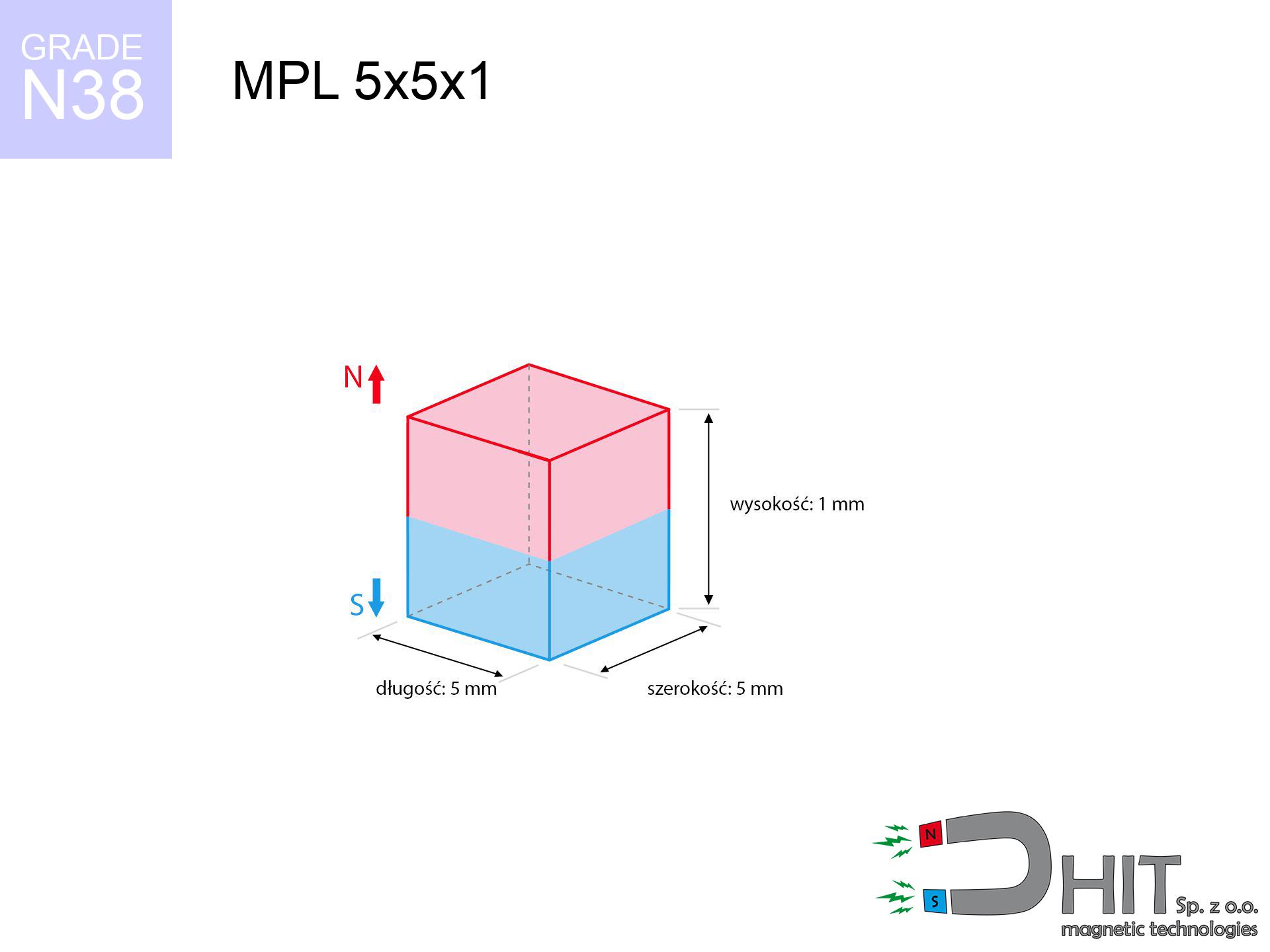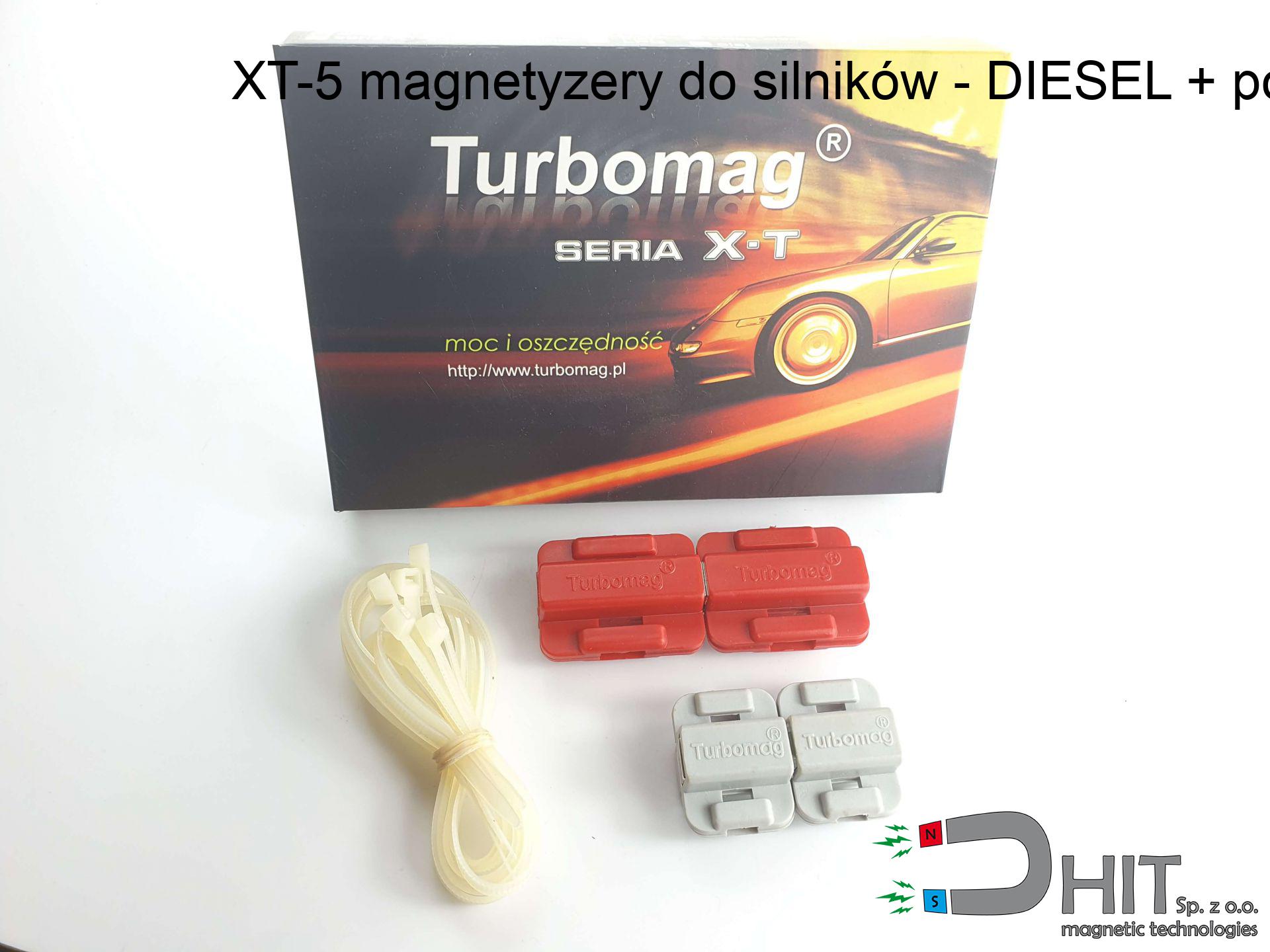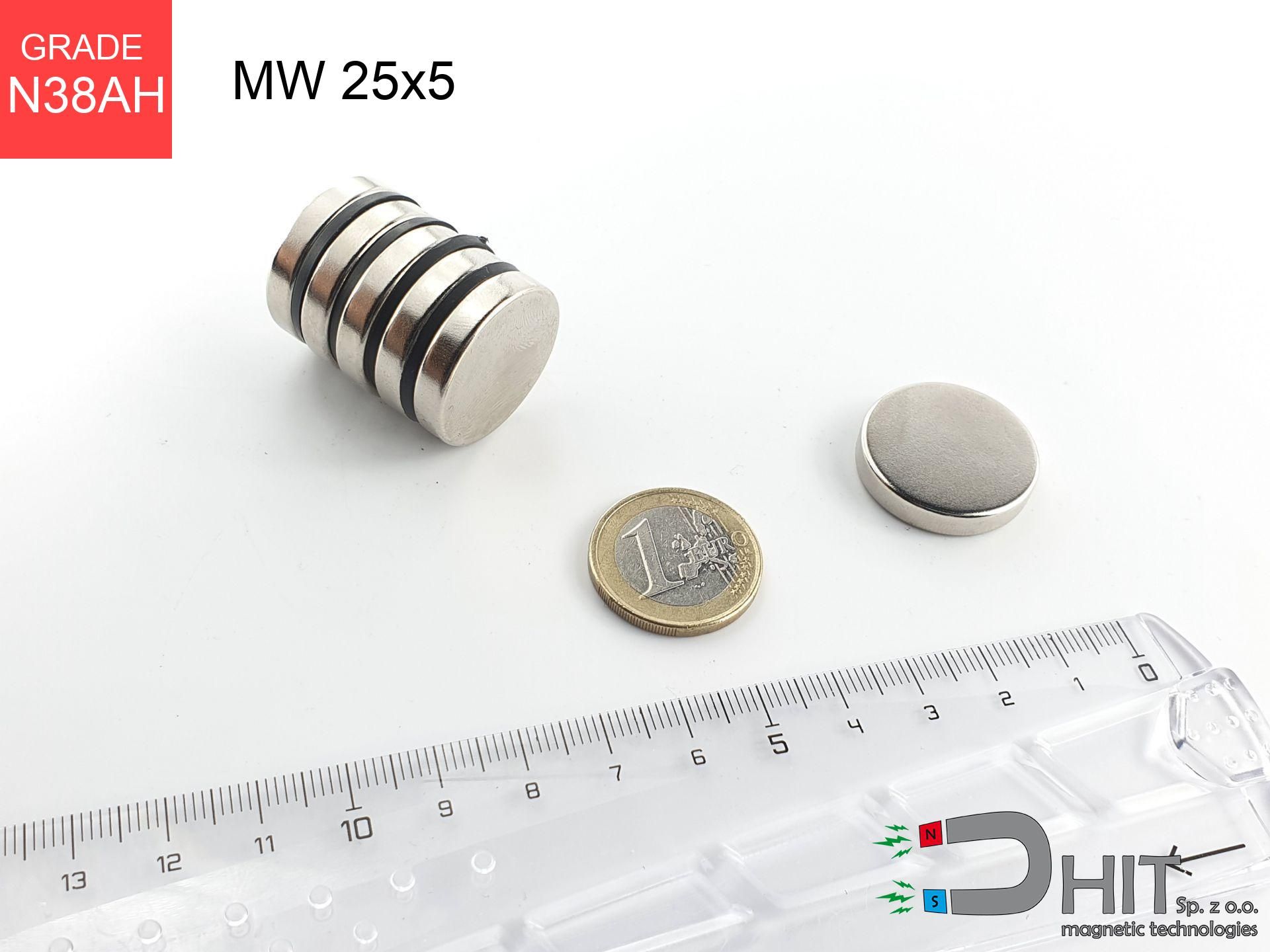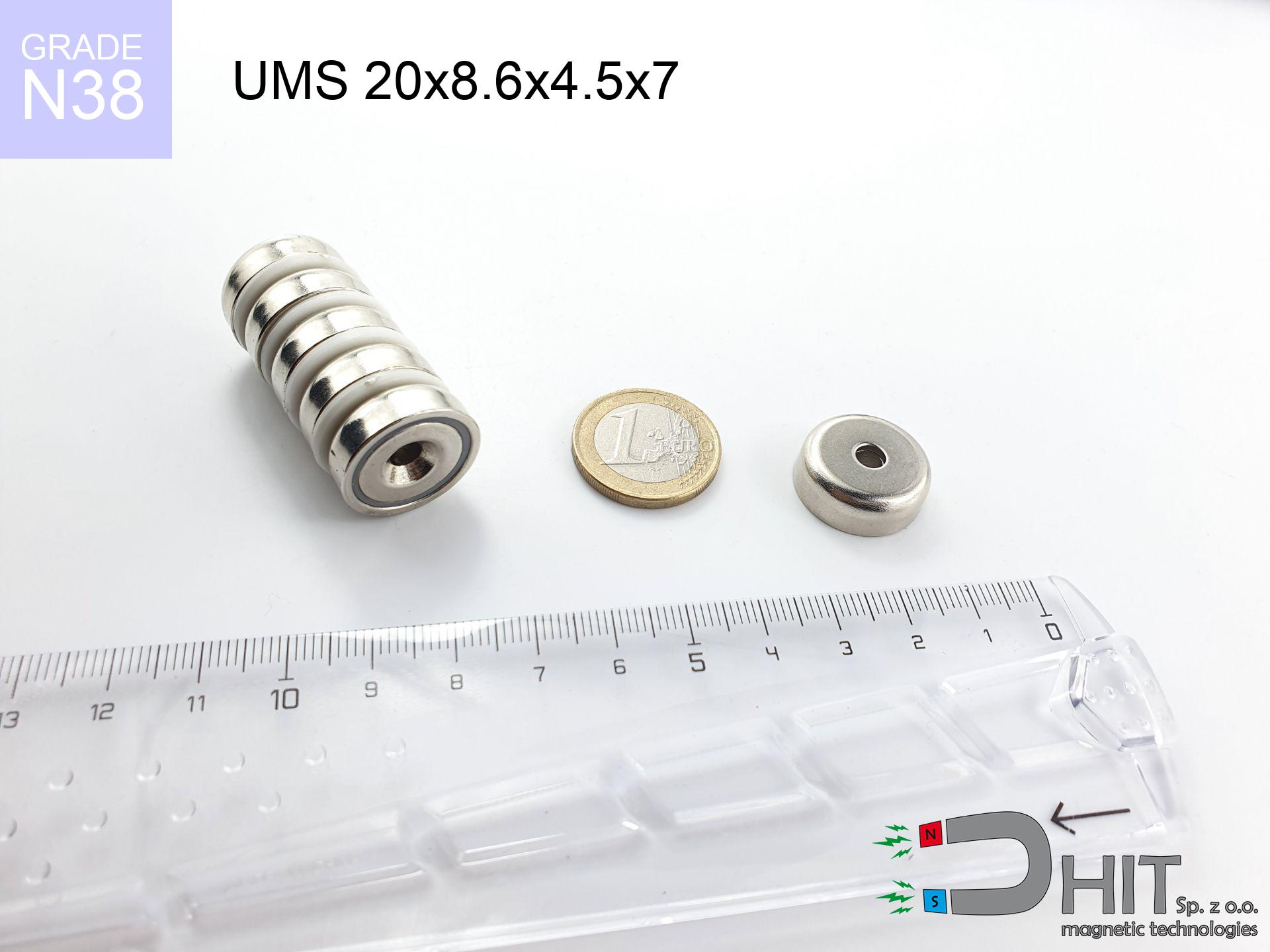MPL 5x5x1 / N38 - lamellar magnet
lamellar magnet
Catalog no 020170
GTIN: 5906301811763
length [±0,1 mm]
5 mm
Width [±0,1 mm]
5 mm
Height [±0,1 mm]
1 mm
Weight
0.19 g
Magnetization Direction
↑ axial
Load capacity
0.39 kg / 3.82 N
Magnetic Induction
209.53 mT
Coating
[NiCuNi] nickel
0.1845 ZŁ with VAT / pcs + price for transport
0.1500 ZŁ net + 23% VAT / pcs
bulk discounts:
Need more?Need help making a decision?
Pick up the phone and ask
+48 22 499 98 98
if you prefer send us a note through
our online form
through our site.
Force along with shape of a magnet can be calculated using our
force calculator.
Same-day processing for orders placed before 14:00.
Magnetic properties of material N38
Physical properties of sintered neodymium magnets Nd2Fe14B at 20°C
Shopping tips
Advantages and disadvantages of neodymium magnets.
Besides their durability, neodymium magnets are valued for these benefits:
- They do not lose strength, even during around 10 years – the decrease in power is only ~1% (according to tests),
- They are noted for resistance to demagnetization induced by external field influence,
- Thanks to the smooth finish, the plating of Ni-Cu-Ni, gold-plated, or silver gives an elegant appearance,
- Neodymium magnets deliver maximum magnetic induction on a contact point, which ensures high operational effectiveness,
- Through (adequate) combination of ingredients, they can achieve high thermal resistance, enabling functioning at temperatures approaching 230°C and above...
- Due to the option of free forming and customization to specialized solutions, magnetic components can be modeled in a variety of forms and dimensions, which makes them more universal,
- Fundamental importance in electronics industry – they are used in hard drives, brushless drives, medical devices, and technologically advanced constructions.
- Compactness – despite small sizes they provide effective action, making them ideal for precision applications
Drawbacks and weaknesses of neodymium magnets: tips and applications.
- Susceptibility to cracking is one of their disadvantages. Upon strong impact they can break. We advise keeping them in a strong case, which not only secures them against impacts but also raises their durability
- When exposed to high temperature, neodymium magnets suffer a drop in strength. Often, when the temperature exceeds 80°C, their strength decreases (depending on the size and shape of the magnet). For those who need magnets for extreme conditions, we offer [AH] versions withstanding up to 230°C
- They rust in a humid environment. For use outdoors we suggest using waterproof magnets e.g. in rubber, plastic
- We recommend a housing - magnetic holder, due to difficulties in producing threads inside the magnet and complex shapes.
- Health risk related to microscopic parts of magnets pose a threat, in case of ingestion, which becomes key in the context of child health protection. Furthermore, small elements of these magnets can complicate diagnosis medical in case of swallowing.
- With mass production the cost of neodymium magnets is economically unviable,
Magnetic strength at its maximum – what contributes to it?
The declared magnet strength refers to the limit force, obtained under optimal environment, meaning:
- with the use of a yoke made of low-carbon steel, guaranteeing full magnetic saturation
- whose thickness equals approx. 10 mm
- with a plane perfectly flat
- without the slightest clearance between the magnet and steel
- for force acting at a right angle (in the magnet axis)
- at ambient temperature room level
Determinants of lifting force in real conditions
In practice, the actual holding force results from many variables, listed from crucial:
- Distance – the presence of foreign body (paint, dirt, gap) interrupts the magnetic circuit, which lowers power steeply (even by 50% at 0.5 mm).
- Angle of force application – highest force is obtained only during pulling at a 90° angle. The force required to slide of the magnet along the surface is typically many times lower (approx. 1/5 of the lifting capacity).
- Plate thickness – too thin steel does not close the flux, causing part of the power to be wasted to the other side.
- Steel type – mild steel gives the best results. Alloy admixtures decrease magnetic permeability and holding force.
- Surface structure – the smoother and more polished the surface, the larger the contact zone and stronger the hold. Unevenness creates an air distance.
- Thermal factor – high temperature weakens pulling force. Exceeding the limit temperature can permanently demagnetize the magnet.
* Lifting capacity was determined using a polished steel plate of suitable thickness (min. 20 mm), under perpendicular detachment force, however under shearing force the lifting capacity is smaller. In addition, even a minimal clearance {between} the magnet and the plate lowers the lifting capacity.
Warnings
Heat warning
Do not overheat. Neodymium magnets are susceptible to temperature. If you require operation above 80°C, inquire about HT versions (H, SH, UH).
Fire risk
Fire warning: Rare earth powder is explosive. Avoid machining magnets in home conditions as this may cause fire.
Keep away from children
Absolutely store magnets out of reach of children. Risk of swallowing is high, and the consequences of magnets clamping inside the body are fatal.
Compass and GPS
Navigation devices and smartphones are highly susceptible to magnetic fields. Direct contact with a powerful NdFeB magnet can ruin the internal compass in your phone.
Beware of splinters
Despite metallic appearance, neodymium is delicate and not impact-resistant. Do not hit, as the magnet may shatter into sharp, dangerous pieces.
Electronic hazard
Data protection: Neodymium magnets can ruin payment cards and delicate electronics (heart implants, hearing aids, timepieces).
Medical implants
Warning for patients: Powerful magnets affect electronics. Keep minimum 30 cm distance or request help to work with the magnets.
Crushing risk
Risk of injury: The pulling power is so immense that it can cause hematomas, crushing, and even bone fractures. Use thick gloves.
Sensitization to coating
Allergy Notice: The nickel-copper-nickel coating contains nickel. If skin irritation occurs, cease working with magnets and wear gloves.
Powerful field
Be careful. Neodymium magnets act from a distance and connect with massive power, often quicker than you can react.
Important!
Learn more about hazards in the article: Magnet Safety Guide.






![SM 25x350 [2xM8] / N42 - magnetic separator SM 25x350 [2xM8] / N42 - magnetic separator](https://cdn3.dhit.pl/graphics/products/sm-25x350-2xm8-pim.jpg)


